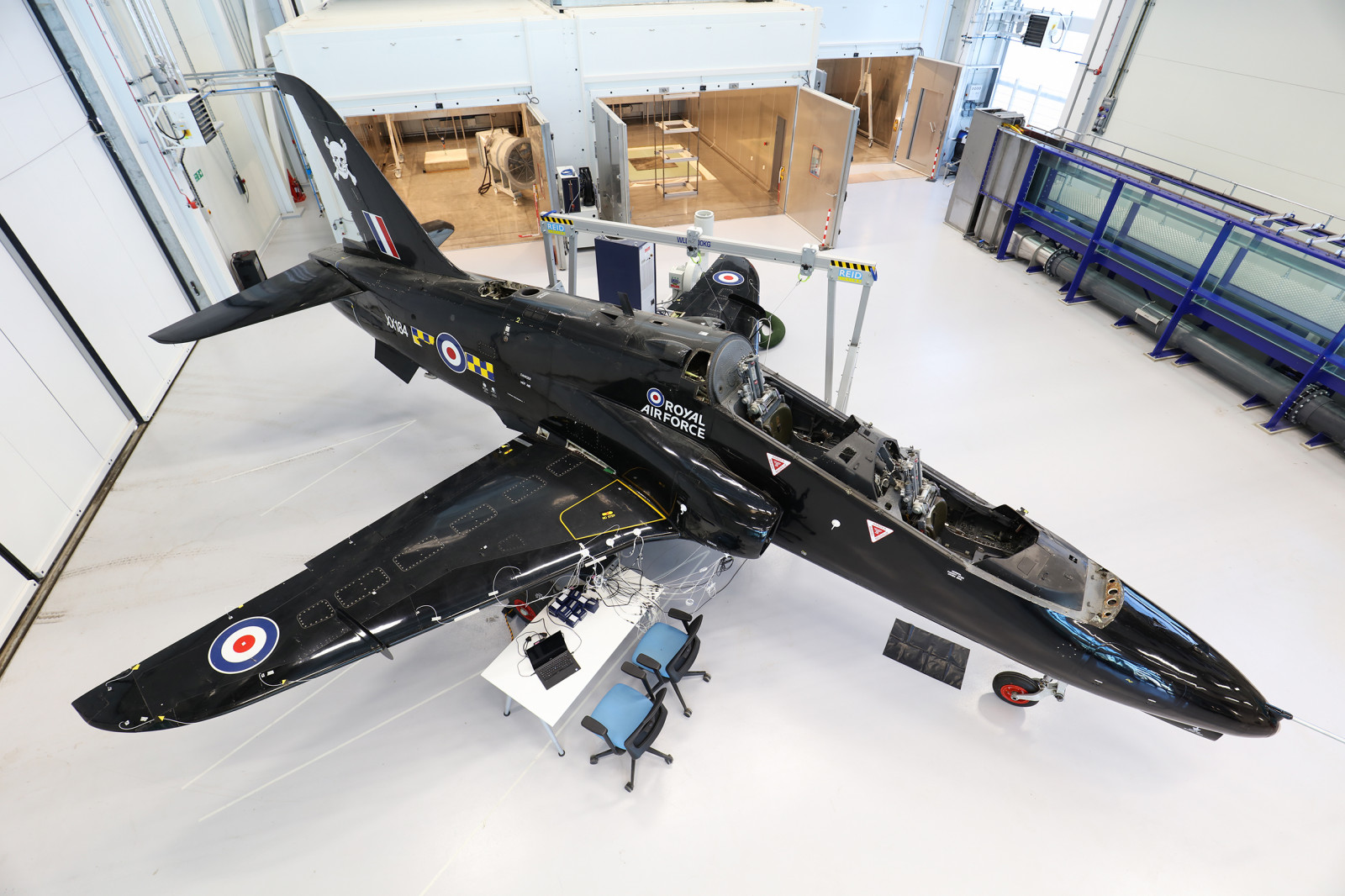Digital twins for high-value engineering applications (DTHIVE) project to make use of state-of-the-art LVV facility

Funder: The Alan Turing Institute/EPSRC
Lead: Professor David Wagg, Professor of Nonlinear Dynamics, Department of Mechanical Engineering, University of Sheffield
Other contributors: Advanced Manufacturing Research Centre (AMRC)
Grant: £898,048
Dates: 1 October 2021 – 31 March 2022
Background
Digital twins (DTs) are radically reshaping most aspects of modern technology. A key objective of a DT is that it can faithfully capture time-evolutionary behaviour of the physical twin. Significant value and advantage can then be obtained by monitoring data and anticipating changes that happen over time, e.g. for asset management, scheduling of operation and maintenance, extending operational life and increasing security and resilience, to mention just a few tasks. At present, there is only a very rudimentary understanding of how the time-evolution of a DT will work. Understanding more completely the dynamics and control of the twin across a range of time scales is the central research question of this proposal. More specifically, it will focus on high-value engineering applications from aerospace to civil infrastructure.
At a societal level, DTs will be a key part of solutions for; green energy (e.g. asset management of offshore wind farms; healthcare (e.g. personalised medicine); smart cities (e.g. managing energy consumption); more efficient manufacturing (e.g by reducing costs and increasing time efficiency) to name some key applications.
Goals
- To establish a centre of excellence for research in digital twins for high-value engineering applications, DTHIVE, with the initial objective of establishing the foundations of a time-evolving DT.
- To bring together researchers from across disciplinary boundaries to drive forward the understanding, development, and integration of DT science and technology.
- To provide a regional research hub that has important links with key UK industries such as aerospace, automotive, infrastructure and renewable energy, that will accelerate advancements in DT research into direct societal impact.
The new centre will be based in Sheffield and act as a regional focus for the North of England. The launch of the new centre would be timed to coordinate with the overarching activities of the planned ATI Centre of Excellence for DT Technology. The centre will establish close connections with other universities and industry partners in the region; e.g., via the Sir Henry Royce Centre for Materials Research.
DTHIVE will act as a regional hub within the planned ATI Centre of Excellence for Digital Twin Technology; it will be based on the existing Sheffield DT community of practice, across AMRC and the Faculty of Engineering.
The project will make use of the Laboratory for Verification and Validation (LVV), funded by £11M from EPSRC, ERDF and University of Sheffield. Our state-of-the-art facility has already been used to develop an operational platform for a digital twin of a three-storey structure. This open-source platform (https://github.com/Digital-Twin-Operational-Platform/Cristallo) will be used as a template for the work proposed here.
Sheffield is uniquely placed to deliver the DTHIVE centre, in terms of both research profile and geographical location. AMRC are already a highly-influential regional hub and UK centre of excellence for manufacturing research (including AMRC North West). The Faculty of Engineering has teams of researchers working on key DT topics from dynamics & control, machine learning, uncertainty analysis to computer security.
The core expertise in dynamics is critical; dynamics is central to DT capability and fidelity, in terms of both capturing response behaviour of structures and systems on the micro/millisecond scale and evolution on the scale of years.
The timing of this bid is highly fortuitous; the EPSRC Programme Grant on DTs for dynamics, managed by Wagg, is 3.5 years into its term, with significant research results being generated; now is the time to extend the vision of that project to encompass users and applications beyond the immediate team and build critical links across UK. The highly-engaged DigiTwin industry partners, together with AMRC subscribers and those in the wider Turing community will nucleate the new hub perfectly. Significant momentum has been created which should not be allowed to dissipate.
The expected impact will be to create a centre of excellence that delivers; (i) significant contribution to the Turing 2.0 (& Government) levelling-up agenda, and development of a regional hub, (ii) accelerates the underpinning scientific understanding and exploitation of digital twins in an engineering context, and (iii) delivers impact to UK-based industry.
The DTHIVE research hub will provide a focal point for academic, industrial and policy stakeholders in DT technology in the North of England. Establishing such a hub will foster collaboration, accelerate translation of technology and coordinate effort in the region. The benefits of such a hub are in the facilitation of cross-disciplinary research, a clear unified path for industrial engagement and the promotion of DT innovation as part of the Turing 2.0 ‘levelling-up’ agenda. In terms of DT dynamics and control research the DTHIVE hub would be considered a national and international centre of excellence. For example, the DigiTwin project was among the first UK & international projects to focus on DT research in this domain, and as a result rapid progress has already been made on real structures, e.g. DTOP-Cristallo mentioned above.
Workpackages
WP1: Aerospace DT. A fixed-wing (Hawk) and rotorcraft (Lynx) will be used as physical twins (PTs). We will build and commission tests to enable ground vibration tests (GVTs) of these PTs to be conducted via a DT test platform. The novel contribution is that the DT will be able to reflect how the operational conditions of the structure change between the test environment (GVT) and conditions in use (i.e. in flight). A key goal will be to establish and demonstrate methods for validation of the DTs, where comprehensive in-service testing is not possible. The testing will begin with single-shaker testing using commercial software (a traditional modal setup), progressing to testing which is linked to, and informed by, the digital twin model, including full multi-shaker tests. This will be one of the first demonstrations of a DT on such full-scale aerospace structures.
WP2: Manufacturing processes. Part 2.1: Create a fully connected digital twin of the filament winder, oven & 5-axis CNC machine, along with near-full connectivity between the different manufacturing processes using the current backbone of AMRC’s Factory+ specification. For the first time, this would enable prediction of condition of supply before the next manufacturing process begins & operational data to identify opportunities for future efficiency gains. Part 2.2: Chatter in the machining process leads to poor surface quality and results in tool damage. Existing monitoring methods can only detect severe chatter when poor surface quality and damage to the cutter have already happened. In this project, a machine learning-based model will be developed as a digital twin of the machining process, and be applied to marginal chatter detection. The model will be validated by machining trials.
WP3: Energy Modelling Digital Twin: the UK government has committed to a heat pump system deployment rate of 600,000 per year by 2028. University of Sheffield has designed and prototyped a multispectral advanced research vehicle (MARVel): a van mounted mobile sensing rig that captures high volumes of street-level urban data. The new idea is to use hyperspectral data at different wavelengths to provide effective information for a wide range of applications that would not be possible with composite imagery alone. Information on material makeup can be used to build material stock models and to understand and infer characteristics when combined with other information, e.g. thermal radiation.



